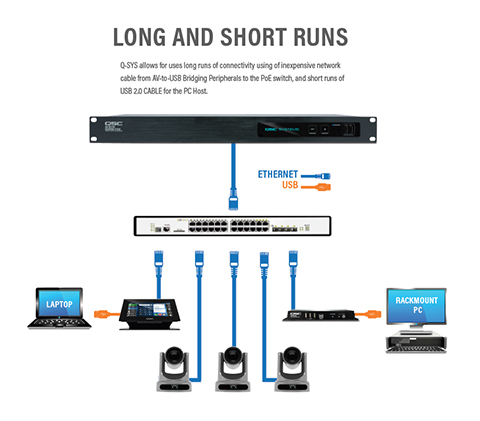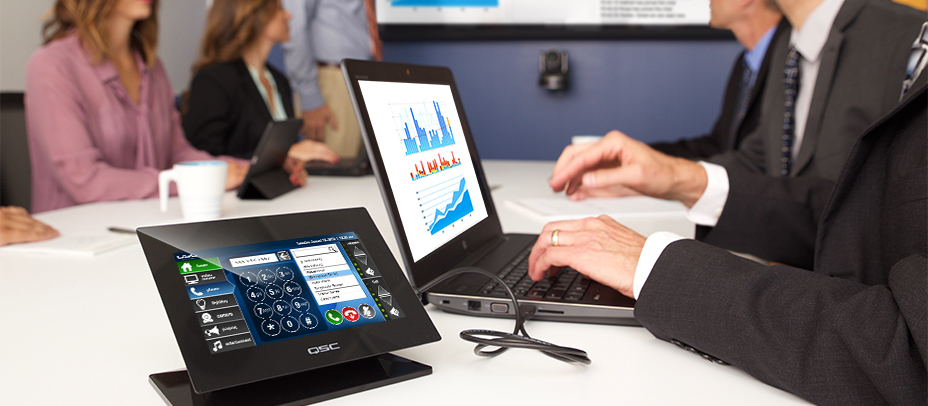Just in case you missed it, here’s a breakdown of our live demonstration of the new Q-SYS™ AV-to-USB Bridging solution at Infocomm 2016.
To set the stage, we had two practical conference rooms positioned on either side of the booth. Both fit six to seven people and connected via Skype for Business™.
We started by re-introducing last year’s Q-SYS conferencing solution:
- Q-SYS Core 110f – with 24 I/Os plus USB, POTS, and VoIP you’ve got a lot of capabilities in a single chassis product.
- TSC-7t Tabletop Touch Screen Controller – you may be using as a simple dialer, or enlist more complex room control including video source select, lighting and blind control, etc.
- SPA Series ENERGY STAR® amplifier – offers two or four channels which you know is the sweet spot for the conference room.
Next, we asked the attendees how they might add video camera capabilities to this room. Something that pairs with the current soft codec application that’s running in your conference room.
Good Technology, Bad Implementation 
One option is an average USB-based camera, which is great for personal use but has real limitations in the corporate setting. You have cable length limitations (10-15 feet max), not to mention you can’t terminate in the field! And you probably need to add a third-party USB extender, which is expensive, hard to manage, and unpredictable with some devices.
Then there’s the HDMI-based camera, which comes with similar cable limitations, and you’ll need an additional line to run power. USB and HDMI are point-to-point solutions, so if you need multiple cameras or multiple endpoints for BYOD, you’re again stuck with adding more equipment to an already crowded credenza.
Enter The Q-SYS AV-to-USB Bridging Solution
With our demo, we pointed out the TSC-7t on the conference table and the Q-SYS PTZ-IP based conference camera mounted to the wall and detailed how we solved the traditional USB/HDMI limitations with an IP-based platform – the AV-to-USB Bridging solution.
This solution uses USB and networking in a smarter way. It uses standard network equipment for long run transport, and USB for short transport. The Q-SYS conference cameras and bridging devices connect to the network via CAT-5 or higher and the end points (BYOD user PC or rackmount PC) access the Q-SYS audio and video stream via USB connection on either Q-SYS bridging device.
QSC even offers a few different choices for bridging devices – the Q-SYS I/O-USB Bridge, which easily mounts next to a rackmount PC or under a table, or the Q-SYS TSC-7t tabletop controllers, which comes with a Micro-USB access point for easy tabletop access.
Just like that, we showed showgoers how the AV-to-USB Bridging solution eliminates those painful extenders or patchwork solutions you’re probably using now.
Network-to-Many Paradigm
Since these devices are networked, they transform the standard conferencing paradigm of “point-to-point connectivity” into a “network-to-many” paradigm. This allows you to install as many Q-SYS conference cameras in a room as you want, and as many Q-SYS bridging devices as you need, without an additional matrix switcher.
The cherry on top is the PoE connectivity for both Q-SYS conference camera and bridge. You don’t need to run separate power if you don’t want to!
What Did Attendees Have to Say?
We showed this demo to a few hundred people over the three-day show and received a lot of positive response.
An AV Engineering Manager for an IV League School was among the impressed parties. For him, “having a device that can sit on the network and easily extend to other endpoints makes it look like a beneficial and easy-to-use solution.”
The USB camera is ideal for his environment. “The bane of our existence with today’s web conferencing trends is trying to extend USB. Having a solution that can extend a USB camera and high-quality audio over the network makes it very attractive,” he said.
For more information on the AV-to-USB Bridging solution, watch this video.
If you’re interested in adding an IP-based conferencing solution to your room, click hier.
Patrick Heyn
Neueste Artikel von Patrick Heyn (alle ansehen)
- Evolving the AV Experience: Unlocking the Power of the Q-SYS Full Stack AV Platform - May 15, 2025
- Q-SYS Work From Home Webinar Series - April 14, 2020
- Welcome to QSC! - January 16, 2020
